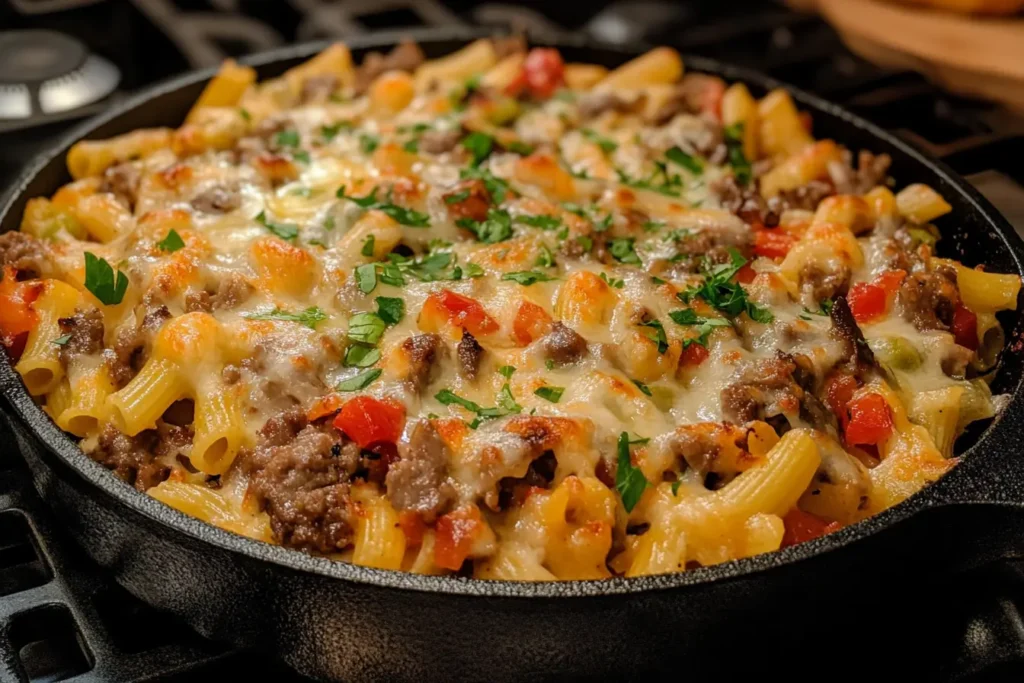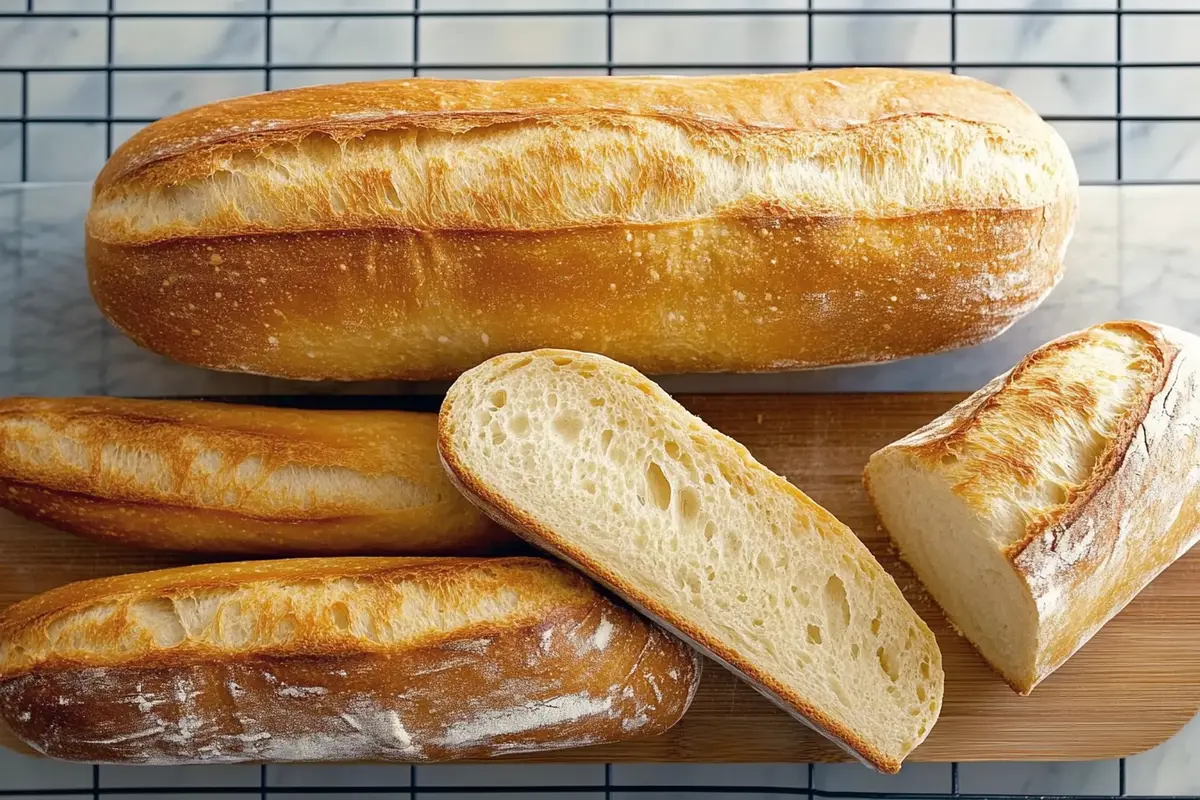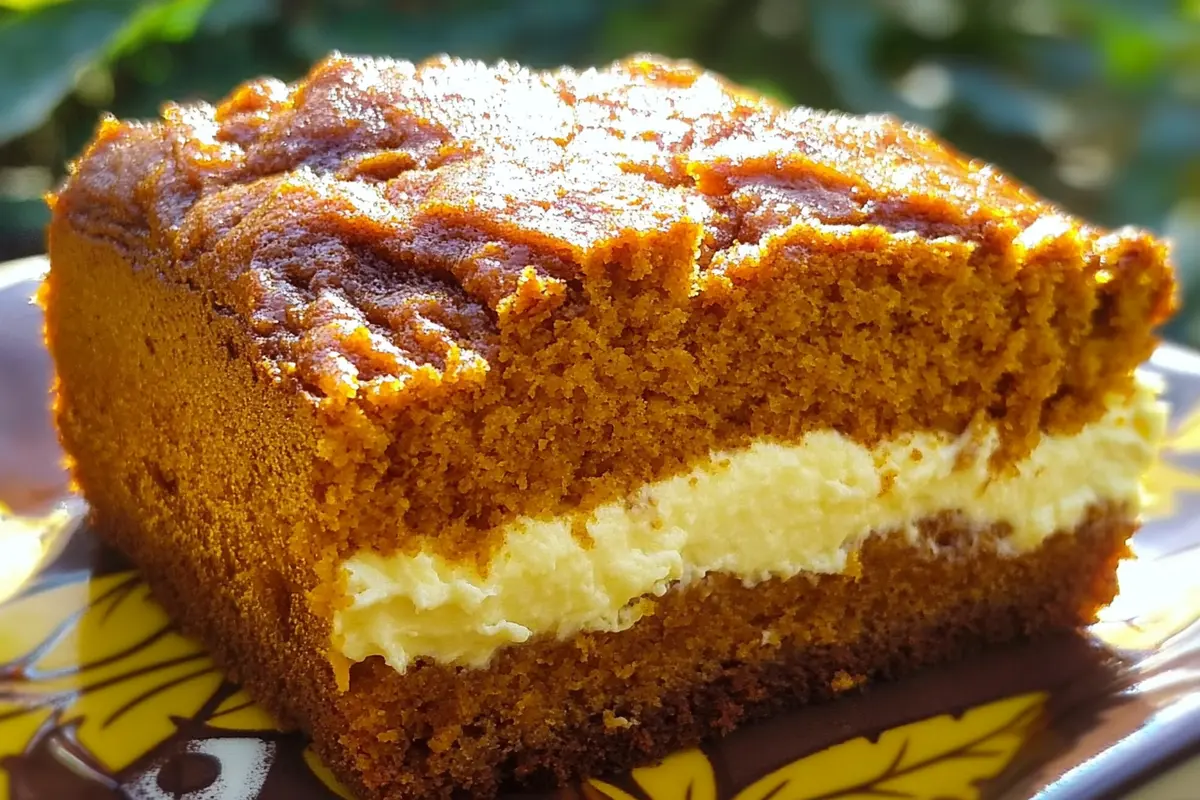What happens when you bring together the iconic Philly cheesesteak and the ever-versatile pasta? You get a culinary masterpiece that combines the best of both worlds: the Philly Cheesesteak Pasta Recipe. This dish fuses the savory, cheesy goodness of a traditional cheesesteak with the comforting satisfaction of a creamy pasta dish. Whether you’re a foodie exploring fusion cuisines or a home cook looking to wow your family, this recipe is your ticket to success.
Table of Contents
Introduction to Philly Cheesesteak Pasta Recipe
Fusion of Classic Flavors
Imagine the hearty flavors of a classic Philly cheesesteak—thinly sliced beef, sautéed onions, bell peppers, and gooey cheese—reimagined in a pasta dish. This fusion combines the comfort of pasta with the bold, savory notes of the original sandwich. By pairing tender pasta with creamy cheese and rich beef, this recipe creates a crowd-pleaser for both cheesesteak lovers and pasta enthusiasts.
Popularity and Appeal
In recent years, fusion dishes like Philly Cheesesteak Pasta have gained immense popularity due to their innovative flavors and ease of preparation. The ability to take familiar, beloved ingredients and transform them into something new has captured the hearts of food lovers everywhere. Best of all, this dish is versatile—it works as a hearty weeknight dinner or a show-stopping centerpiece for gatherings.
This recipe embraces simplicity and quality, making it accessible to novice cooks while offering endless possibilities for culinary creativity. So, if you’re ready to take your cooking skills up a notch, stay tuned as we break down everything you need to know about this delicious dish.
Understanding the Origins
The History of the Philly Cheesesteak
The Philly cheesesteak is a culinary icon that traces its roots back to Philadelphia in the early 20th century. It all began when Pat Olivieri, a hot dog vendor, decided to grill some beef and onions on his cart one day. The enticing aroma caught the attention of a taxi driver, and soon, the simple creation evolved into a beloved sandwich served on crusty rolls. Over time, the addition of melted cheese elevated the dish into a cheesy, savory masterpiece.
Origins in Philadelphia
Philadelphia remains the spiritual home of the cheesesteak. It’s a city where debates rage over the best spot to grab this sandwich, from Pat’s King of Steaks to Geno’s Steaks. Each vendor adds its own unique twist, but the essence of the dish stays rooted in its simplicity and bold flavors.
Traditional Ingredients
At its core, a Philly cheesesteak is made with thinly sliced ribeye beef, caramelized onions, and cheese—often provolone, Cheez Whiz, or American cheese—served on a soft, chewy hoagie roll. The sandwich is indulgent, hearty, and utterly satisfying.
Evolution into Pasta Dishes
The leap from sandwich to pasta is a testament to the adaptability of the cheesesteak’s flavors. Modern chefs and home cooks alike sought to reimagine the dish by incorporating the same elements into a creamy, comforting pasta dish. The result? A recipe that’s just as hearty and indulgent but offers a whole new texture and experience.
Modern Culinary Innovations
Pasta-based takes on the Philly cheesesteak started popping up in food blogs and cookbooks as fusion cuisine gained traction. By pairing tender beef and savory vegetables with pasta, this innovation brought a fresh perspective to a timeless classic. The addition of cheese sauces—ranging from sharp cheddar to creamy provolone—ensures that the pasta remains faithful to the dish’s cheesy heritage.
Popularity of Fusion Recipes
Dishes like Philly Cheesesteak Pasta have soared in popularity because they combine comfort food elements with new twists. These recipes appeal to adventurous eaters while remaining approachable for anyone who loves familiar flavors. By transforming a classic dish into something novel, they demonstrate the endless possibilities of culinary creativity.
Ingredients Breakdown
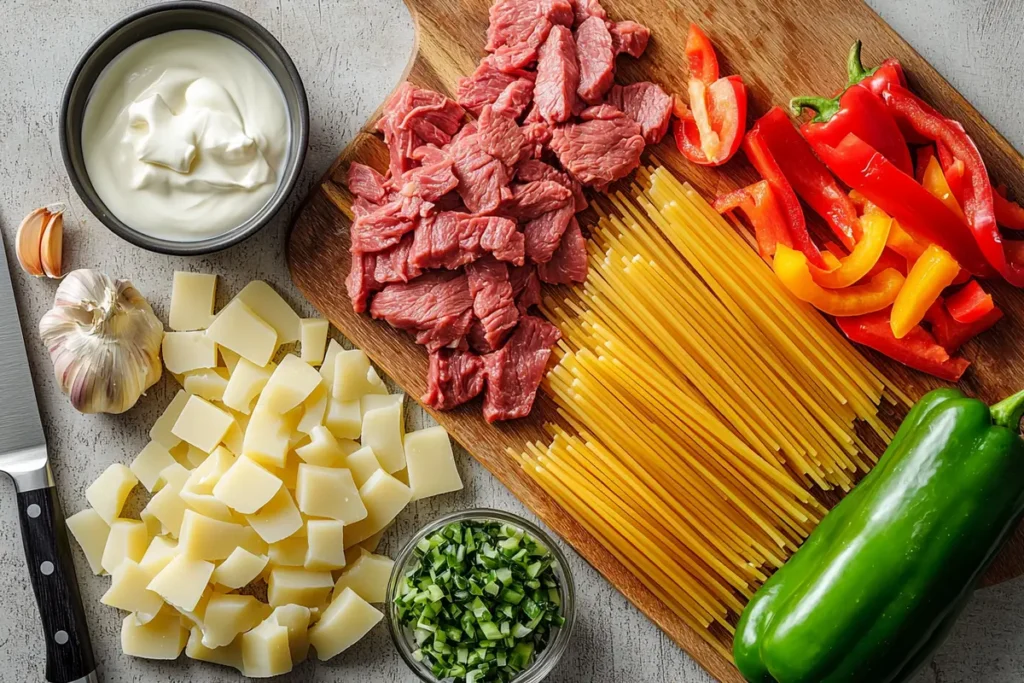
Essential Components of the Recipe
Every great dish starts with the right ingredients, and Philly Cheesesteak Pasta is no exception. The beauty of this recipe lies in how its carefully chosen components come together to create a harmonious blend of flavors and textures. Here’s a closer look at what makes this dish truly exceptional.
Choosing the Right Cut of Beef
For authentic cheesesteak flavor, it’s crucial to select the right cut of beef. Ribeye is the top choice due to its marbling and tenderness. Its rich flavor ensures the meat stays juicy and flavorful, even after cooking. However, flank steak or sirloin can also work if sliced thinly against the grain to maintain tenderness. The key is cooking it quickly over high heat to lock in the juices.
Selection of Pasta Types
When it comes to pasta, choosing the right shape is essential. Rigatoni, penne, or rotini are ideal for this recipe because their ridges or curves hold the creamy cheese sauce perfectly. Short pasta also makes for easier eating and a more cohesive dish. Avoid long pastas like spaghetti, as they may not complement the dish’s hearty elements.
Importance of Fresh Vegetables
Vegetables like onions and bell peppers are the backbone of the classic Philly cheesesteak flavor profile. Sautéed to caramelized perfection, these veggies add sweetness and depth. Using fresh, crisp produce enhances the dish’s overall quality. Optional additions like mushrooms or garlic can provide an extra layer of earthiness for a more robust flavor.
Cheese Varieties for Authentic Flavor
Cheese is the star of this recipe, so picking the right variety matters. Provolone offers a mild, creamy flavor, while sharp cheddar adds a tangy kick. For a nostalgic touch, some prefer American cheese for its smooth meltability. Mixing cheeses creates a balanced, rich sauce that satisfies every palate.
Substitutions and Dietary Considerations
Whether you’re catering to specific dietary needs or simply experimenting, this dish is easily adaptable. Substitutions allow you to maintain the spirit of the recipe while meeting individual preferences.
Vegetarian and Vegan Alternatives
For a vegetarian twist, replace the beef with plant-based protein such as seitan, tofu, or jackfruit. Mushrooms, particularly portobellos, are a fantastic substitute because they mimic the meaty texture. Vegan cheese alternatives made from cashews or almonds can be used to replicate the creamy cheesiness, while coconut cream adds richness to the sauce.
Gluten-Free Pasta Options
Gluten-free eaters can still enjoy Philly Cheesesteak Pasta by opting for gluten-free pasta made from chickpeas, rice, or quinoa. These alternatives provide the same satisfying texture and absorb the cheese sauce beautifully. Just be sure to cook the pasta to the perfect al dente consistency to avoid mushiness.
Step-by-Step Cooking Instructions
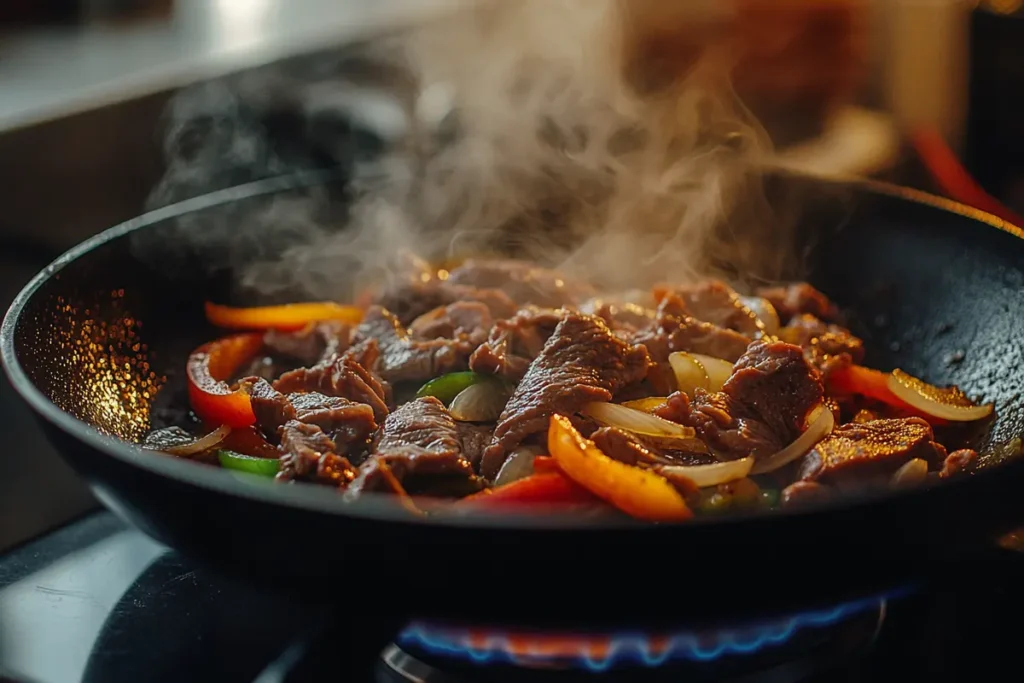
Preparing the Beef for Philly Cheesesteak Pasta Recipe
Slicing Techniques for Tenderness
Start by selecting a high-quality cut of beef for the Philly Cheesesteak Pasta Recipe, such as ribeye or sirloin. For the most tender slices, place the beef in the freezer for about 20–30 minutes to firm it slightly. Then, using a sharp knife, slice the beef thinly against the grain. This technique shortens the muscle fibers, ensuring a melt-in-your-mouth texture when cooked. The right beef preparation is a cornerstone of achieving the perfect flavor in this dish.
Marinating for Enhanced Flavor
To elevate the taste, marinate the beef. Combine olive oil, soy sauce, minced garlic, and a splash of Worcestershire sauce in a bowl. Add the sliced beef and let it rest for at least 20 minutes. This step infuses the meat with flavor while tenderizing it further.
Cooking Vegetables for Philly Cheesesteak Pasta Recipe
Sautéing Onions and Peppers
Heat a drizzle of olive oil in a large skillet over medium-high heat. Add thinly sliced onions and bell peppers, stirring occasionally until softened and slightly caramelized. This process typically takes 6–8 minutes. The caramelization enhances their natural sweetness, complementing the savory elements of the dish.
Optional Additions: Mushrooms and Garlic
For added depth, throw in sliced mushrooms and minced garlic during the last few minutes of cooking the onions and peppers. Mushrooms bring an earthy richness, while garlic infuses the mixture with a robust aroma. Cook until the mushrooms are tender and the garlic is fragrant, about 2–3 minutes.
Combining Ingredients
Cooking the Pasta to Al Dente
Bring a large pot of salted water to a boil. Add your chosen pasta, such as rigatoni or penne, and cook until al dente—usually 1–2 minutes less than the package instructions. Drain the pasta but reserve about 1 cup of pasta water for the sauce, as it helps achieve a silky texture.
Integrating Beef and Vegetables
In the same skillet used for the vegetables, sear the marinated beef slices over high heat until just cooked through, about 2–3 minutes per side. Return the cooked vegetables to the skillet, mixing them with the beef to evenly distribute the flavors.
Creating the Cheese Sauce
Reduce the heat to medium and pour in heavy cream or milk. Gradually add shredded provolone, cheddar, or your preferred cheese blend, stirring continuously until melted and creamy. If the sauce feels too thick, add a splash of the reserved pasta water to loosen it. Season with salt and pepper to taste.
Final Assembly and Serving Suggestions
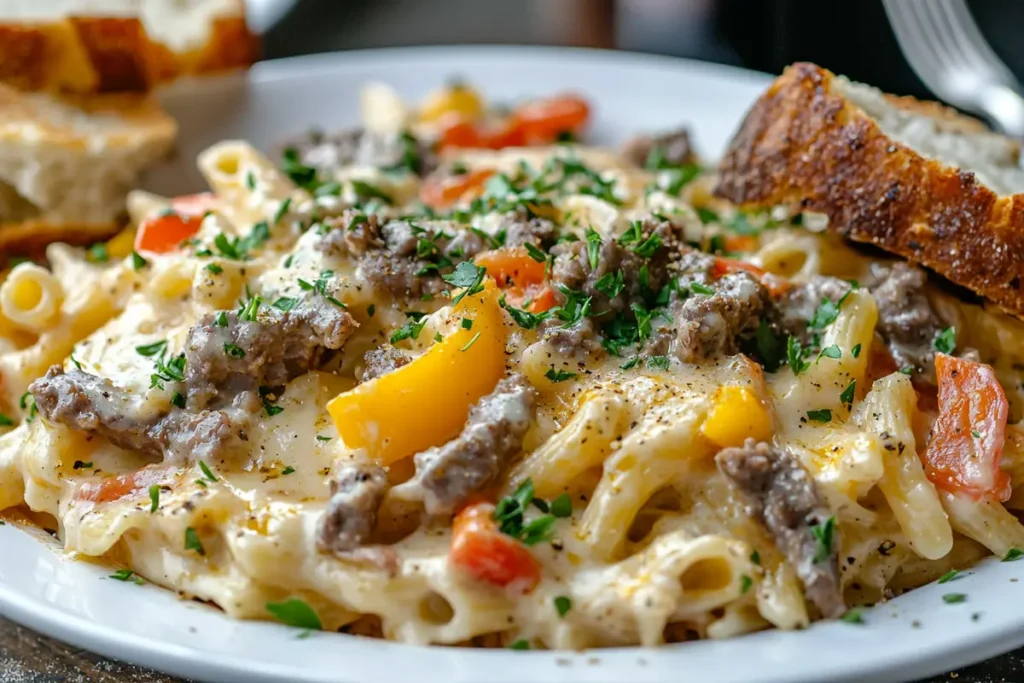
Garnishing Ideas
Combine the cooked pasta with the beef and vegetable mixture, ensuring every bite is coated in the rich cheese sauce. Plate the dish and garnish with freshly chopped parsley for a pop of color. Sprinkle a little grated Parmesan on top for extra indulgence.
Recommended Side Dishes
Serve your Philly Cheesesteak Pasta alongside crusty garlic bread or a light side salad for balance. Roasted vegetables or sautéed green beans also pair wonderfully with this creamy, hearty dish, adding both texture and nutrition.
Tips and Tricks for the Perfect Dish
Ensuring Optimal Flavor Balance
Seasoning Adjustments
The secret to a standout Philly Cheesesteak Pasta Recipe lies in striking the perfect balance of flavors. Taste as you go! Add salt and pepper gradually to avoid over-seasoning. A dash of smoked paprika or garlic powder can also enhance the savory depth. For a bit of brightness, a squeeze of lemon juice or a pinch of red pepper flakes can bring a zesty contrast to the creamy richness.
Balancing Cheese and Creaminess
Cheese selection plays a vital role in flavor balance. Using a mix of sharp cheddar for tang and provolone for creaminess creates depth without overpowering the dish. To avoid an overly heavy sauce, use cream sparingly and rely on reserved pasta water to adjust the consistency. This trick ensures the sauce clings to the pasta without feeling overly rich or cloying.
Common Mistakes to Avoid
Overcooking the Pasta
Nobody enjoys mushy pasta! Cooking your pasta to a perfect al dente is non-negotiable for this recipe. Al dente pasta not only holds its shape better but also absorbs the cheese sauce more effectively. Be sure to set a timer and taste-test during the last minute of boiling. Undercooking slightly is better than overcooking since the pasta will continue to soften when mixed with the sauce.
Preventing a Greasy Sauce
A greasy sauce can ruin the dish’s appeal. To prevent this, use high-quality cheeses and avoid overcooking them at high heat. Stir the cheese into the sauce over low to medium heat to ensure a smooth, emulsified texture. Skimming excess fat from the beef during cooking can also reduce grease without compromising flavor.
Frequently Asked Questions
Can I use chicken instead of beef?
Absolutely! While traditional Philly cheesesteak calls for beef, chicken can be a fantastic alternative. Use thinly sliced chicken breast or thighs for the best texture and flavor. Season the chicken similarly to the beef, and cook it until it’s juicy and tender. Chicken adds a lighter twist to the dish while still complementing the creamy cheese sauce and sautéed vegetables.
What type of cheese is best for this recipe?
The best cheeses for this dish are provolone, sharp cheddar, or American cheese due to their smooth melting properties and rich flavor. For a balanced taste, you can mix different cheeses. Provolone delivers mild creaminess, while cheddar adds a sharper edge. Avoid pre-shredded cheese, as it often contains anti-caking agents that hinder smooth melting. Grating your cheese fresh ensures a silky, flavorful sauce.
How can I make this dish healthier?
To make a healthier version, consider these adjustments:
- Swap heavy cream with a light cream or milk alternative.
- Use whole wheat or high-protein pasta made from chickpeas or lentils.
- Replace some or all of the cheese with nutritional yeast for a cheesy flavor without extra calories.
- Increase the vegetable ratio by adding more bell peppers, mushrooms, or even spinach for extra nutrients.
Can I prepare this dish ahead of time?
Yes! You can prepare parts of this dish in advance to save time. Cook the beef, vegetables, and pasta separately and store them in airtight containers in the refrigerator. Make the cheese sauce fresh when you’re ready to serve, as reheating cheese sauces can sometimes cause them to separate. Assemble everything just before serving to maintain optimal texture and flavor.
What wine pairs well with Philly Cheesesteak Pasta?
While wine is often paired with pasta dishes, this creamy, cheesy recipe is better complemented by non-alcoholic beverages like sparkling water or iced tea for balance. If you prefer wine, consider white grape juice for a family-friendly pairing.
How do I store and reheat leftovers?
To store leftovers, transfer the cooled pasta into an airtight container and refrigerate for up to 3 days. For reheating, warm it gently in a skillet over low heat, adding a splash of milk or cream to revive the sauce’s creamy consistency. Avoid using the microwave, as it can overheat the sauce and dry out the dish. With proper reheating, your pasta will taste just as delicious as it did on day one!
Print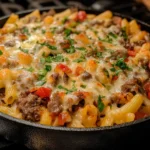
Philly Cheesesteak Pasta Recipe: A Delicious Fusion Dish
- Total Time: PT35M (35 minutes)
- Yield: 4 servings 1x
Description
This Philly Cheesesteak Pasta Recipe is a delicious fusion of the iconic Philly cheesesteak and creamy, cheesy pasta. Featuring tender slices of beef, sautéed bell peppers and onions, and a rich, velvety cheese sauce, this dish delivers bold flavors in every bite.
Ingredients
For the Pasta:
- 12 oz rigatoni (or penne, rotini)
- 1 teaspoon salt (for boiling water)
For the Beef & Vegetables:
- 1 tablespoon olive oil
- 1 lb ribeye steak or sirloin, thinly sliced
- ½ teaspoon salt
- ½ teaspoon black pepper
- 1 teaspoon Worcestershire sauce
- 1 small onion, thinly sliced
- 1 red bell pepper, diced
- 1 green bell pepper, diced
- 2 cloves garlic, minced
For the Cheese Sauce:
- 1 ½ cups whole milk
- 1 cup heavy cream
- 1 ½ cups shredded provolone cheese
- ½ cup shredded sharp cheddar cheese
- ½ teaspoon garlic powder
- ½ teaspoon onion powder
- ½ teaspoon smoked paprika (optional)
- ½ teaspoon Dijon mustard (for extra flavor)
- ¼ teaspoon red pepper flakes (optional, for heat)
For Garnishing:
- ¼ cup chopped fresh parsley
- ¼ cup grated Parmesan cheese (optional)
Instructions
Step 1: Cook the Pasta
- Bring a large pot of salted water to a boil.
- Add the pasta and cook until al dente, following the package instructions (typically 10–12 minutes).
- Drain the pasta, reserving ½ cup of pasta water for later use. Set aside.
Step 2: Cook the Beef
- Heat olive oil in a large skillet over medium-high heat.
- Season the thinly sliced beef with salt, pepper, and Worcestershire sauce.
- Add the beef to the skillet and cook for 2–3 minutes per side, until browned and cooked through.
- Remove the beef from the skillet and set it aside.
Step 3: Sauté the Vegetables
- In the same skillet, add the sliced onions and diced bell peppers. Sauté for about 5 minutes, until softened.
- Stir in the minced garlic and cook for another 30 seconds, until fragrant.
Step 4: Prepare the Cheese Sauce
- Lower the heat to medium and pour in the milk and heavy cream, stirring to combine.
- Gradually add the shredded provolone and cheddar cheese, stirring constantly until fully melted and smooth.
- Season with garlic powder, onion powder, smoked paprika, and Dijon mustard.
- If the sauce is too thick, add a splash of reserved pasta water to reach the desired consistency.
Step 5: Assemble the Dish
- Return the cooked beef to the skillet and stir to combine with the vegetables and sauce.
- Add the drained pasta, tossing everything together until fully coated in the creamy cheese sauce.
- Simmer for 1–2 minutes to allow the flavors to meld.
Step 6: Serve and Garnish
- Transfer to a serving dish and sprinkle with fresh parsley and grated Parmesan.
- Serve immediately and enjoy!
Notes
- Store leftovers in an airtight container in the refrigerator for up to 3 days.
- Reheat on the stovetop over low heat, adding a splash of milk to keep the sauce creamy.
- Prep Time: PT15M (15 minutes)
- Cook Time: PT20M (20 minutes)
- Category: Dinner, Pasta
- Method: Stovetop
- Cuisine: American, Fusion
Nutrition
- Serving Size: 1/4 of recipe
- Calories: 650 kcal
- Sugar: 5g
- Sodium: 750mg
- Fat: 38g
- Saturated Fat: 20g
- Unsaturated Fat: 14g
- Trans Fat: 0.5g
- Carbohydrates: 50g
- Fiber: 4g
- Protein: 35g
- Cholesterol: 95mg
Keywords: Philly cheesesteak pasta, cheesy beef pasta, comfort food, Philly cheesesteak recipe, pasta with steak, creamy pasta recipe, skillet pasta

